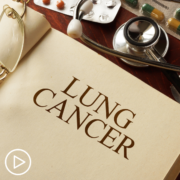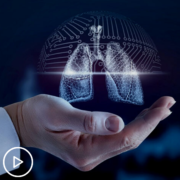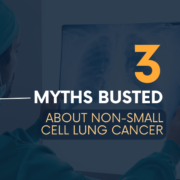Do Veterans Face Health Disparities in Lung Cancer Care?
Do Veterans Face Health Disparities in Lung Cancer Care? from Patient Empowerment Network on Vimeo.
Are there any lung cancer disparities that veterans face? Expert Dr. Michael Kelley from Duke University School of Medicine discusses smoking rates of veterans, the quality of VA care versus the general population, potential environmental exposures during military service, and proactive advice for optimal lung cancer care.
[ACT]IVATION TIP
“… if you have cancer, then you should be taken care of in a way which addresses your needs regardless of what the availability is within the VA system. VA sometimes cannot take care of all patients with cancer, and in that case, VA will purchase a service in the community.”
Download Resource Guide | Descargar guía de recursos
See More from [ACT]IVATED NSCLC Veterans
Related Resources:
Transcript:
Lisa Hatfied:
Dr. Kelley, can you discuss any disparities or differences in health outcomes among veterans compared to the general population when it comes to access to treatment? And are there systemic issues within the healthcare system that disproportionately affect veterans?
Dr. Michael Kelley:
So there are some differences between what types of cancers that veterans get and the general population, but there is not a bright line difference between those two groups. They’re really gradations, and if you have the same type of cancer and you’re in the VA versus outside the VA, the treatment approaches and prognosis should be the same.
And that’s actually what we see when you look at systematic studies of the quality of care of inside the VA compared to the rest of the country. The VA care, it looks the same or better almost routinely, and that is, I think, due to the uniform availability of services that are not only the medical care, but some wraparound services that are available to veterans.
There are some differences that we want to talk about. One is related to smoking. So military veterans have a higher rate of previous smoking. The current smoking rate is about the same as the general population, so it’s more likely that they will get smoking-related malignancies, and, of course, lung cancer is one of those cancers.
Military veterans also have exposures during their service to a lot of other physical, chemical, and other types of exposures, which can increase their risk of a variety of different types of cancers. And those can also show up in different subpopulations within the services depending on where they served. But many studies that explored some types of associations that were thought to be existent turned out not to show a difference.
So, for example, breast cancer and active duty military women is actually lower than it is in the general population. So there are some differences, but they go both ways. So I don’t want to make any general statements. But my activation tip is that, if you have cancer, then you should be taken care of in a way which addresses your needs regardless of what the availability is within the VA system. VA sometimes cannot take care of all patients with cancer, and in that case, VA will purchase a service in the community.
Share Your Feedback
Create your own user feedback survey









![[ACT]IVATED NSCLC Biomarkers Resource Guide II [ACT]IVATED NSCLC Biomarkers Resource Guide II](https://powerfulpatients.org/wp-content/uploads/ACTIVATED-NSCLC-Biomarkers-Resource-Guide-II-180x180.png)



